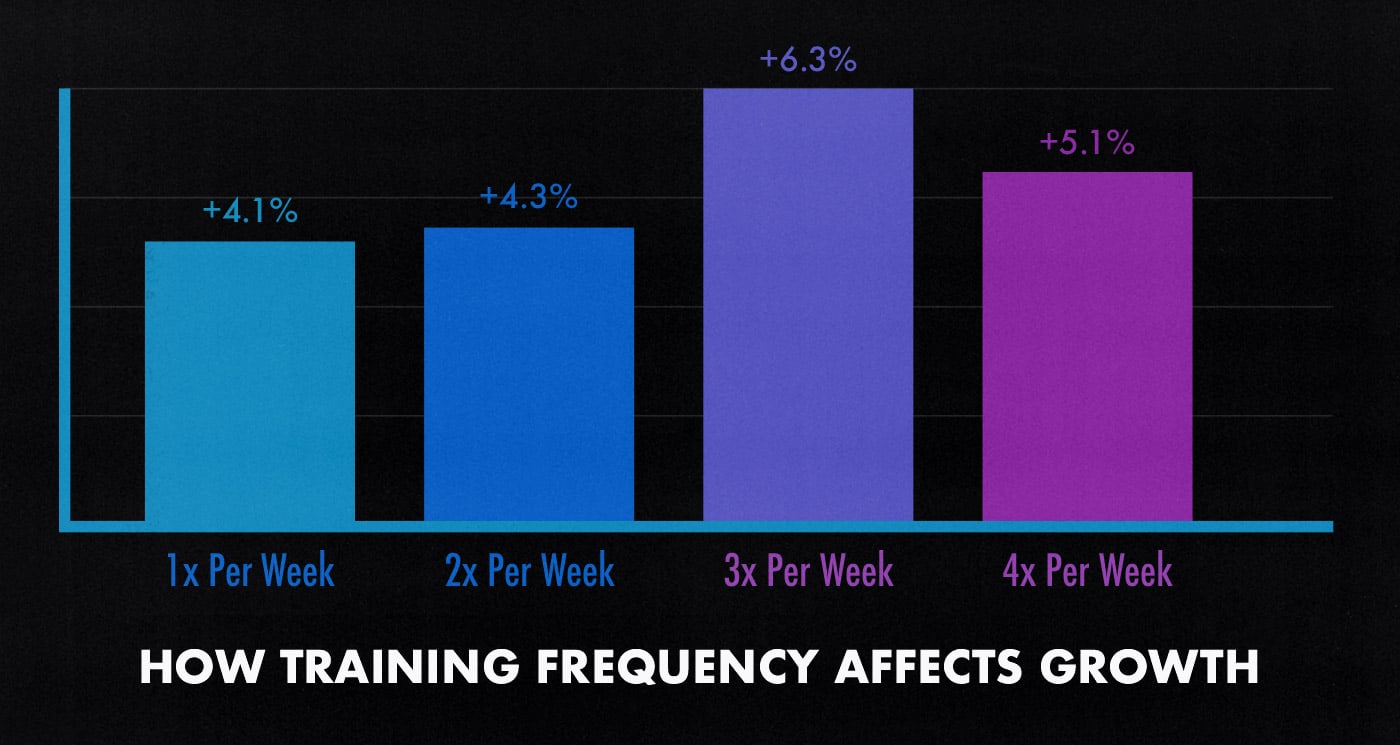
How Often Should You Train Each Muscle Group?
Training each muscle group 2–4 times per week can maximize muscle growth while keeping your risk of overuse injuries low. But that isn’t the only way to train. Some workout programs train each muscle group once per week. Some recent research suggests those routines can be just as effective. Or at least that’s how it appears from afar. We need to delve deeper.

The Schoenfeld Training Frequency Studies
For the past few decades, most casual bodybuilders have been training their muscles once per week. They follow Bro Splits with a Chest Day, Back Day, Arm Day, Shoulder Day, and sometimes even a Leg Day. They blast each muscle into the ground, give it plenty of time to recover, and then train it even harder than before.

In 2016, Schoenfeld published a meta-analysis showing that training your muscles 2+ times per week stimulated 80% more muscle growth (meta). Since then, the evidence-based bodybuilding community has been pillorying Bro Splits, decrying them as unscientific, even silly.
Schoenfeld updated his meta in 2019 (meta). One of the big changes he made was considering training volume. It’s common for people who train more often to do more total sets per muscle group. Perhaps that was driving the extra muscle growth.

When we compare people who did the same total number of sets per week, training a muscle group more often still yielded more muscle growth, but the differences were less dramatic.
The Pedersen Training Frequency Study
Last month, in March of 2024, Pedersen published a new study comparing people who trained each muscle group once per week versus four times per week (study):
- Low-frequency: trained 1 day per week, doing 20 sets per workout (20 total).
- High-frequency: trained 4 days per week, doing 5 sets per workout (20 total).
There weren’t any significant differences in muscle growth between groups. At first glance, that seems at odds with Schoenfeld’s findings. I think it helps to look deeper.

The participants who trained their muscles more often gained twice as much strength. That’s probably because they practiced lifting weights more often, improving their coordination. Frequency is a huge part of learning. Every time you sleep, you consolidate your learning, allowing you to benefit from more practice.
Training more often also yielded 20% more muscle growth. That difference in muscle growth didn’t reach statistical significance, but that’s hardly an argument in favour of lower training frequencies. Rather, it’s just that the study was too small to draw any firm conclusions.
The Weekend Warrior Study
An even newer study by Lei and colleagues found that people who exercise only on the weekends do about as well as people who exercise steadily throughout the week. The participants were similarly lean, fit, and healthy (study).
Mind you, the participants were doing cardio, not hypertrophy training. The researchers didn’t measure muscle growth. What’s interesting, though, is that there were virtually no differences. If anything, the weekend warriors were doing slightly better.
I suspect that, given enough time, we’d see the same thing with people who lift weights. It doesn’t seem to me that training more often does a better job of helping people overcome plateaus. So, even if training more often stimulates slightly more muscle growth, as long as you can do enough work to make progress, you can reach your genetic potential.
Summary
I think there are two ways to look at this research. The obvious conclusion is that training more often gives you much greater strength gains and slightly faster muscle growth. There are a few possible explanations for why that might happen:
- The more often you practice your exercises, the faster your coordination improves. Plus, the more fatigued a muscle is from previous sets, the harder it is to practice good technique.
- Training a muscle every few days will keep it growing steadily throughout the week. A workout stimulates 1–4 days of muscle growth, so training your muscles 2–4 times per week would keep them growing all week long. In theory, that would help you get faster, leaner muscle growth. In practice, the benefit seems small.
- The law of diminishing returns kicks in as you do more sets per muscle per workout. Doing a 9th set of chest exercises might not stimulate much extra muscle growth. Doing a 16th set might not stimulate any extra growth at all.
- Training a muscle group more often gives you an opportunity to benefit from adding more sets. Instead of doing 12 sets once per week (12 total sets), you could do 5 sets thrice per week (15 total sets), giving you +3 sets every week. Those extra sets would give you extra muscle growth.
As the research stands, I think training a muscle 2–3 times per week is the best default. But you could look at the research more skeptically. This latest study didn’t reach statistical significance. Plenty of people get great muscle growth from Bro Splits. Perhaps blasting a muscle until it’s totally pumped and fatigued gives you an adaptation you can’t get from doing just a few sets.
I think it’s wise to try both styles of training at some point. If you’re a beginner, start with a full-body routine that trains your muscles 2–3 times per week. After a few months (or years), try a body-part split that trains your muscles 1–2 times per week. The novelty of the new style of training might stimulate a new wave of muscle growth.
I’ve tried both approaches. I prefer training my muscles more often. But I’ve gotten great results from Bro Splits. Both approaches can definitely work.

Alright, that’s it for now. If you want to know all the ins and outs of building muscle, we have a free newsletter. If you want a full foundational bulking program, including a 5-month full-body workout routine, gain-easy diet guide, recipe book, and online coaching, check out our Bony to Beastly Bulking Program. Or, if you want a customizable intermediate bulking program, check out our Outlift Program.
If you have any questions, drop them below. I’ll answer all the comments.
Shane Duquette is the founder of Outlift, Bony to Beastly, and Bony to Bombshell, each with millions of readers. He's a Certified Conditioning Coach (CCC), has gained 70 pounds, and has over a decade of experience helping more than 15,000 people build muscle. He also has a degree in fine arts, but those are inversely correlated with muscle growth.

Muscle-Building Mini-Course via EMAIL
Sign up for our 5-part muscle-building mini-course that covers everything you need to know about:
Here are some related articles